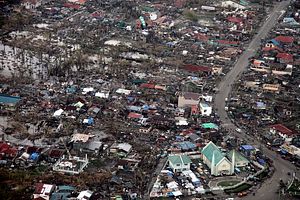Recovery continues to be slow two years after super typhoon Haiyan (known locally as Yolanda) devastated the central part of the Philippines.
To be sure, the failure to complete the rehabilitation process in Tacloban city and Leyte province, the ‘ground zero’ of the typhoon disaster, is seen by some as understandable considering the massive destruction left behind by Haiyan. To reiterate the extent of the damage, Haiyan affected 44 out of 80 provinces in the Philippines. It killed more than 6,000 people and cause more than $2 billion worth of property damage. It is reportedly the strongest typhoon in recorded history.
The government, for its part, has been defending its post-Haiyan relief efforts. A presidential spokesperson even bragged that the Philippines did better compared to the post-Hurricane Katrina performance of the United States government.
But critics have been citing official audit reports about the inefficient use of calamity funds and donations from other countries. They question the slow disbursement of funds intended for Haiyan survivors. They point out that thousands continue to live in temporary shelters or tent cities with inadequate services and livelihood opportunities. The government’s “Build Back Better” initiative is mocked as a program favoring big business at the expense of ordinary residents.
But the government has denied the accusation of underspending. It also countered the charge that it neglected the plight of Haiyan victims. Economic Planning Secretary Arsenio Balisacan insisted that the government is now “transitioning into the medium-term phase of recovery and rehabilitation efforts.”
However, Balisacan acknowledged that “reconstruction efforts were stymied by a whole set of serious policy and implementation issues.” As examples, he identified contradictory policies on procurement and land acquisition as well as the red tape involved in completing certain projects.
“We learned that several national laws, policies, and practices have been getting in the way of resource mobilization and fund disbursement, and have been a major hindrance to project implementation,” he added.
Balisacan’s statement, released a few days before the two-year anniversary of Haiyan, reflected a more moderate assessment of the government’s post-Haiyan achievements. It highlighted the new infrastructure and other economic programs that benefited Haiyan-hit communities, but the statement also mentioned the cause of “implementation bottlenecks” that delayed the delivery of a comprehensive reform package for Haiyan victims.
What Balisacan did not say was that these bureaucratic weaknesses could have been easily addressed through decisive leadership by the national government.
The government of outgoing President Benigno Aquino III will be remembered for its success or failure to restore normalcy in the Eastern Visayas region. Naturally, it is going to be an election campaign issue that can be invoked by opposition candidates in the next few months.
Adding to the pressure is the global media attention that the Philippines faces as it prepares to host the Asia Pacific Economic Cooperation summit this month. If journalists decide to visit Tacloban and report the real situation of the city, it will not be difficult for them to pinpoint the unfulfilled promises and incomplete projects of the administration.
For its part, the government hopes to lead a discussion during the APEC summit about the need for building economies that strengthen the disaster resiliency of countries in the Pacific Rim.
Meanwhile, the deadly impact of Haiyan in a small underdeveloped archipelagic country like the Philippines is expected to be shared once more by climate justice advocates at the Paris Climate Conference next month. Many activists are hoping that the specter of Haiyan will convince world leaders to come up with a more effective climate pact.
Two years after Haiyan made history and traumatized an entire nation, many continue to debate its consequences and the inaction or slow action of concerned agencies. But as bureaucrats, politicians, economists, and climate experts exchange notes on the lessons to be learned from Haiyan, let us not forget that the essential task is still to bring fast relief, real recovery, and progress in the lives of ordinary residents in the communities which have remained calamity areas up to this day.

































